The Power of Geometric Patterns in Graphic Design: Inspiring Examples
Tired of flat, forgettable visuals? Brace yourself for a geometric revolution! This blog is your portal to the captivating world of geometric patterns in graphic design. Dive into inspiring examples, unleash your creativity with shape-tastic tips, and discover how circles, squares, and triangles can transform your designs from meh to magnificent. Ready to make your visuals stand out with timeless style and sharp angles? Buckle up, it’s gonna be a wild ride through the kaleidoscope of geometric awesomeness!
Intro: Using Geometric Shapes in Graphic Design
The visual world around us is a symphony of shapes, colors, and textures. Graphic design, the geometric art of using these elements to communicate ideas and messages, plays a crucial role in shaping our understanding of the world. From the logos on our favorite products to the infographics we encounter online, graphic design weaves its magic through a variety of forms and functions.
And within this diverse realm of graphic design, geometric shapes hold a special place. These fundamental building blocks, like circles, squares, and triangles, have transcended time and culture to become a universal language of design. Their simplicity and inherent order offer a sense of balance, stability, and clarity, making them incredibly versatile tools for designers.
Geometric patterns, born from the repetition and arrangement of these shapes, add another layer of intrigue and visual interest to design. From the intricate tessellations of Islamic art to the bold stripes of modern fashion, geometric patterns can be playful, sophisticated, or anything in between. Their ability to evoke emotions, tell stories, and guide the eye makes them invaluable tools for designers seeking to create impactful and memorable experiences.
This blog delves into the fascinating realm of geometric patterns in modern graphic design. We’ll explore their rich history, uncover the psychological associations’ different shapes hold, and showcase inspiring examples of how designers use geometry across various fields are using them to create stunning and effective designs.
So, get ready to be amazed by the variety of shapes, repetition of shapes, and colors with geometric patterns that can be used to create a cohesive design. Prepare to be inspired by awesome geometric patterns and geometric design patterns that complement your design. And most importantly, discover how you can harness the power of geometry to elevate your own design projects and add a touch of timeless appeal to your creative endeavors.
I. The Power of Geometric Design
From the dawn of civilization, humans have been captivated by the beauty and order of geometric shapes. These fundamental building blocks of our universe have found their way into every aspect of our lives, including art, architecture, and of course, graphic design. In this section, we’ll delve into the rich history of several patterns in graphic design, explore the psychology behind different shapes, and discover how you can harness the power of geometry to create stunning and meaningful designs.
Exploring the History of Geometric Patterns in Art and Design
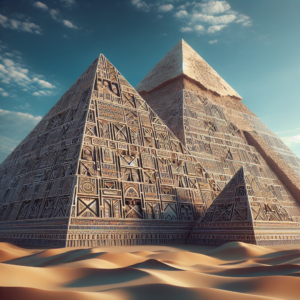
Ancient Civilizations:
Even in the earliest civilizations, we see evidence that geometric patterns can be used in art and architecture.
The Egyptians used pyramids and other geometric forms in their monumental structures, while the Greeks and Romans incorporated geometric elements into their temples, sculptures, and pottery.
These early uses of geometry were often imbued with symbolic meaning, representing order, harmony, and the divine.
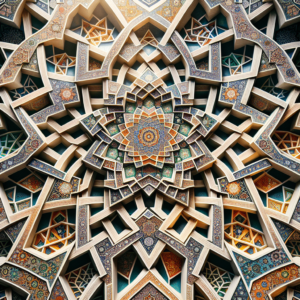
Medieval Art and Islamic Design:
During the Middle Ages, geometric patterns flourished in Islamic art and architecture. Intricate mosaics, arabesques, and tessellations adorned mosques, palaces, and manuscripts.
These patterns were often inspired by mathematics and calligraphy, creating a sense of awe and wonder.
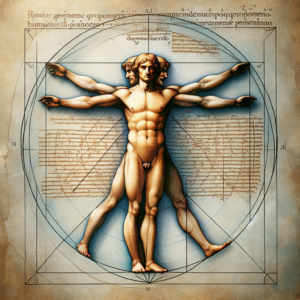
Renaissance and the Rise of Perspective:
The Renaissance saw a renewed interest in classical geometry, with artists like Leonardo da Vinci and Albrecht Dürer using perspective to create realistic and immersive depictions of space.
This era also saw the development of new printing techniques, which led to the widespread dissemination of geometric patterns in decorative arts and graphic design.
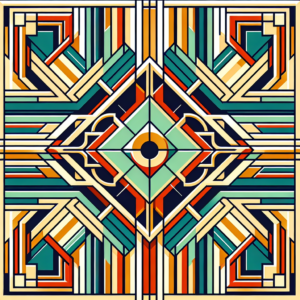
Art Deco and the Modernist Movement:
The early 20th century saw a resurgence of geometric forms in art and design movements like Art Deco and Bauhaus.
These movements emphasized clean lines, bold colors, and geometric shapes, creating a sense of modernity and sophistication.
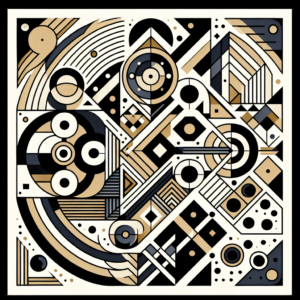
The Digital Age and Beyond:
Today, geometric patterns continue to be a popular digital design choice, thanks in part to the ease with which they can be created and manipulated using digital tools.
We see them used in everything from logos and websites to packaging and fashion.
II. Understanding the Psychology of Shapes
Beyond their visual appeal, geometric shapes carry powerful psychological associations. Each simple shape evokes different emotions and meanings, which can be leveraged by designers to create specific effects and communicate messages effectively.
- Circles: Circles represent unity, infinity, and perfection. These shapes are often used to convey feelings of harmony, peace, and community. Think of the ubiquitous circular logo of Apple or the calming blue circle used by social media platforms like Facebook.
- Squares: Squares symbolize stability, structure, and reliability. They are used to communicate feelings of trust, strength, and order. Think of the iconic square logo of Swiss chocolate brand Lindt or the structured grid layouts used in many websites.
- Triangles: Triangles represent dynamism, action, and direction. They can evoke feelings of power, energy, and excitement. Think of the triangular logo of Adidas or the dynamic triangular compositions used in action movie posters.
By understanding the emotional associations of various shapes used, graphic designers can create designs that resonate with their target audience and effectively communicate their brand message.
III. Unleashing Creativity with Simple Geometric Shapes and Patterns to Complexity
The world of geometric patterns is vast and diverse, offering endless possibilities for creative exploration in graphic design. From the basic and familiar to the intricate and mind-bending, these patterns can add depth, visual interest, and emotional impact to your designs. Let’s dive into the exciting realm of geometric patterns and discover how you can leverage them in your work:
Types of Geometric Patterns and Their Applications:
The beauty of geometric patterns lies in their variety. From the fundamental to the mind-bending, each type offers unique design possibilities. Let’s explore some common categories:
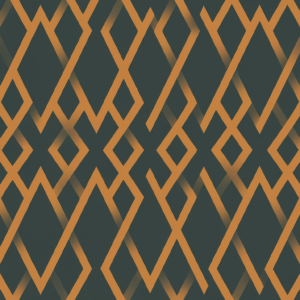
1. Simple Geometric Patterns:
These are the building blocks of the geometric world, often used as standalone elements or combined geometric patterns to create more complex designs.
- Grids: The ever-reliable grid provides structure and organization, perfect for layouts, websites, and infographics. Think of the clean lines in a Swiss-style poster or the grid-based navigation of a minimalist website.
- Stripes: Simple yet impactful, stripes add a touch of dynamism and movement. Imagine the bold stripes of a candy bar wrapper or the classic striped shirt with its timeless appeal.
- Polka Dots: Playful and versatile, polka dots inject a touch of whimsy and fun. Picture the iconic polka-dot dress or the polka-dotted geometric background of a vintage children’s book.
2. Complex Patterns:
For those seeking a deeper dive, complex patterns offer intricate details and mesmerizing effects.

- Fractals: These self-similar patterns, like snowflakes or ferns, exhibit infinite detail and a captivating sense of order. Imagine a fractal-inspired logo or a website background with a mesmerizing fractal animation.
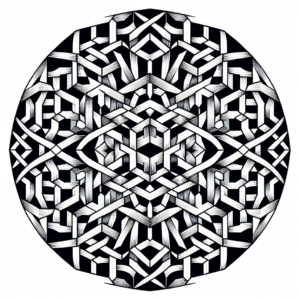
- Tessellations: These interlocking patterns, like honeycomb or Escher’s tessellations, create a sense of continuity and mathematical precision. Picture a tessellated tile pattern on a bathroom floor or a tessellation-inspired geometric artwork with mesmerizing shapes.
3. Geometric Gradients:
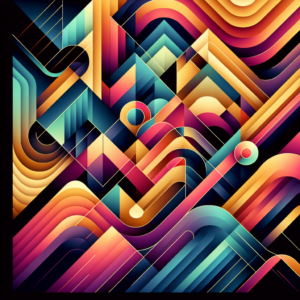
These patterns add a dynamic element to your design by blending different geometric shapes or colors along a gradient. Imagine a logo with a subtle gradient or a website background that transitions between different geometric shapes.
Beyond these categories, the possibilities are endless. Geometric patterns can be found in decorative design, isometric design, and even art installations. The use of geometric shapes can create a sense of movement, emphasize specific shapes and elements, or simply add visual interest.
Make Your Own Geometric Patterns!
Don’t be intimidated by the seemingly complex world of geometric patterns. Creating geometric on your own is easier than you think! Here are some methods to get you started:
Manual Methods:
- Pen and paper: The classic approach! Sketch out your ideas, experiment with different basic shapes like circles, squares, or triangles and arrangements, and let your creativity flow.
- Rulers and compasses: For precise geometric shapes, these tools offer accuracy and control.
Digital Tools:
- Using Graphic design software: Programs like Adobe Illustrator offer a vast array of tools and shapes to create intricate patterns.
- Online pattern generators: Explore online platforms that allow you to easily create and customize geometric patterns.
Remember:
- Start simple: Don’t overwhelm yourself with complexity right away. Begin with basic geometric shapes and gradually build your skills.
- Experiment and explore: Don’t be afraid to try different combinations of shapes, colors, and sizes. The more you experiment, the more you’ll discover your unique style.
- Look for inspiration: Seek out examples of geometric patterns in various design contexts. Observe design principles and how different designers use shapes and patterns to create cohesive and appealing designs.
IV. Inspiring Examples of Geometric Graphic Design
Geometric shapes are more than just building blocks in graphic design; they are powerful tools that can communicate brand identity, create visual interest, and enhance user experience. Let’s dive into captivating examples that showcase the magic of geometric graphic design in action!
Logo Design that Stand Out with Geometric Shapes
From the bitten apple to the iconic swoosh, many famous brands leverage geometric shapes to create instantly recognizable logos. Let’s analyze some iconic examples:
- Apple: The clean, minimalist lines of the bitten apple instantly convey sophistication, simplicity, and innovation, perfectly aligning with Apple’s brand identity. This simple geometric shape has become a global symbol of technology and design excellence.
- Nike: The dynamic swoosh symbol embodies movement, speed, and victory, resonating with the core values of the athletic brand. This powerful geometric design transcends languages and cultures, instantly recognizable to sports enthusiasts worldwide.
- Adidas: The three stripes, a simple yet impactful geometric pattern, represent diversity, unity, and performance. This design choice echoes Adidas’ commitment to inclusion and excellence in the world of sports.
These are just a few examples of how geometric shapes can effectively convey brand identity and message in logo design. By carefully choosing and combining shapes, designers can create logos that are not only aesthetically pleasing but also communicate deep-seated values and emotions.
Web Design that Use Geometric Patterns
Geometric patterns can make websites visually stunning and improve user experience. Let’s explore some captivating examples:
- Spotify: The music streaming platform utilizes intricate geometric patterns on its landing page, creating a dynamic and visually engaging experience that reflects the diverse music library. The patterns add visual interest without distracting from the core functionality of the website.
- Airbnb: The travel platform employs subtle geometric patterns in its navigation menu and background elements. These patterns subtly reinforce the brand’s association with exploration and discovery, enhancing the user journey.
- Pinterest: This visual discovery platform embraces geometric patterns in its interface, organizing content in a visually appealing and easily navigable way. The use of grids and hexagonal shapes creates a sense of order and discovery, reflecting the platform’s focus on visual inspiration.
These examples demonstrate how geometric patterns can enhance user experience by improving navigation, creating visual interest, and reinforcing brand recognition.
Packaging that Pops with Geometric Flair
Packaging is the first impression a product makes, and geometric patterns can be a powerful tool to grab attention and communicate brand values:
- Dove soap: The iconic teardrop shape of the Dove soap bottle is not just aesthetically pleasing; it also symbolizes purity and care. The repetition of the teardrop motif across packaging designs creates a strong brand identity and reinforces the product’s core message.
- Absolut Vodka: The geometric bottle silhouette and label design have become synonymous with the brand. This unique geometric packaging stands out from competitors and reinforces Absolut’s association with modernism and sophistication.
- Toblerone chocolate: The triangular shape of the chocolate bars and the geometric patterns on the packaging create a unique and memorable design, reflecting the brand’s Swiss heritage and premium quality.
By employing geometric patterns on packaging, brands can enhance product appeal, communicate brand values, and stand out on crowded shelves. The key lies in choosing patterns that complement the product’s identity and target audience.
V. Advanced Techniques: Use Geometry for Combining Patterns and Pushing Boundaries
Ready to delve deeper into the exciting world of geometric patterns? Buckle up, because we’re exploring advanced techniques that will take your designs to the next level!
Isometric Patterns: Adding a 3D Dimension
Imagine the familiar grid of a checkerboard, but now tilt it slightly so that the squares appear 3D. That’s the essence of isometric patterns! These captivating designs use consistent angles and proportions to create a sense of depth and dimension within a flat plane.
Unique Visual Impact:
- Depth and perspective: Isometric patterns add a playful layer of depth, making designs more engaging and visually dynamic.
- Modern and trendy: The clean lines and minimalist aesthetic of isometric patterns align perfectly with modern design trends.
- Versatility: From logos and illustrations to website backgrounds and packaging, isometric patterns can be adapted to various design contexts.
Examples in Action:
- Logo Design: Imagine a tech company logo featuring an isometric cube or a coffee shop logo with a 3D coffee cup.
- Website Background: A website for architects could use an isometric cityscape as a background, adding a touch of depth and professionalism.
- Packaging Design: A candy bar wrapper could feature an isometric illustration of the candy itself, creating a more playful and engaging experience.
Embrace the 3D magic of isometric patterns to add a unique and captivating touch to your designs!
Use Patterns to Highlight Specific Elements
Sometimes, you want certain elements within your design to stand out and grab attention. Geometric patterns can be your secret weapon!
Drawing Focus:
- Contrast: Use patterns with contrasting colors or textures to highlight specific elements against a plain background.
- Directional flow: Guide the viewer’s eye towards the desired element by using patterns with lines or shapes pointing in that direction.
- Framing: Create a “frame” around the element with a pattern, drawing attention to its importance.
Examples in Action:
Poster: Use a bold geometric pattern behind a call to action on a poster to make it stand out and encourage viewers to take action.
Infographic: Highlight key statistics or data points by placing them within a contrasting geometric pattern block.
Website Hero Section: Use a subtle geometric pattern on your website’s hero section to draw attention to the main message or image.
Remember, less is more! Use patterns strategically to avoid overwhelming your viewers.
Combining Multiple Patterns for a Bold Look
Feeling adventurous? Combining multiple geometric patterns and shapes can create a bold and eye-catching effect, but it requires careful planning and execution.
The Art of Combining:
- Choose complementary colors: Select patterns with colors that work well together to avoid a clashing visual experience.
- Vary scale and complexity: Combine simple and intricate patterns to create visual interest and hierarchy.
- Maintain balance: Don’t overdo it! Use patterns strategically to avoid overwhelming the viewer.
Examples of Success:
- Fashion Design: A dress with a combination of polka dots and stripes can be both playful and stylish.
- Branding: A brand identity could incorporate a combination of geometric shapes and lines to create a unique and memorable visual language.
- Web Design: A website could use a combination of geometric patterns for different sections, adding visual interest and personality.
Combining patterns can be a powerful design tool, but use it wisely for a cohesive and aesthetically pleasing result.
Conclusion
From ancient art to modern websites, geometric patterns have mesmerized and inspired humankind for centuries. This journey has explored the rich history, the captivating psychology, and the diverse applications of these fundamental geometric design elements.
We’ve seen how geometric shapes are often the building blocks of design elements and can be combined in countless ways to create appealing designs. We’ve delved into basic patterns like grids and stripes, explored the mesmerizing world of patterns like fractals and tessellations, and even discovered the dynamic possibilities of geometric gradients.
Remember, the key to harnessing the power of geometry lies in experimentation. Don’t be afraid to choose the shapes that fit, create patterns, and combine different shapes to find your unique style. Look at some examples of how geometric patterns in various design contexts, use colors and shapes strategically, and let your creativity flow!






